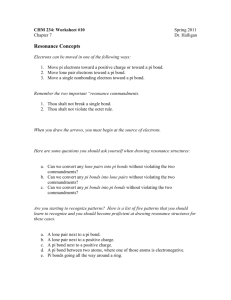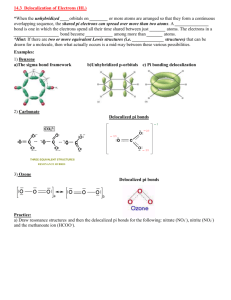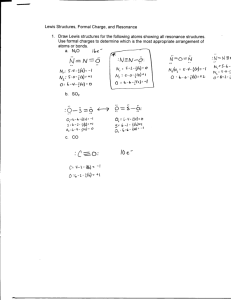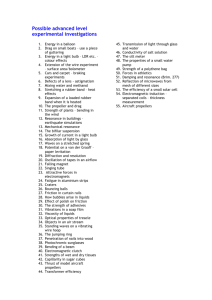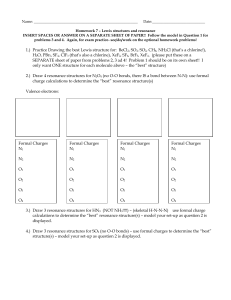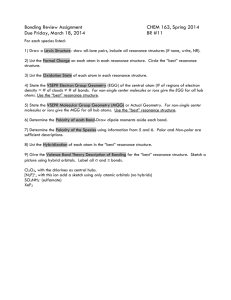Resonance Delocalized Electrons - Organic Chemistry at Arizona
advertisement
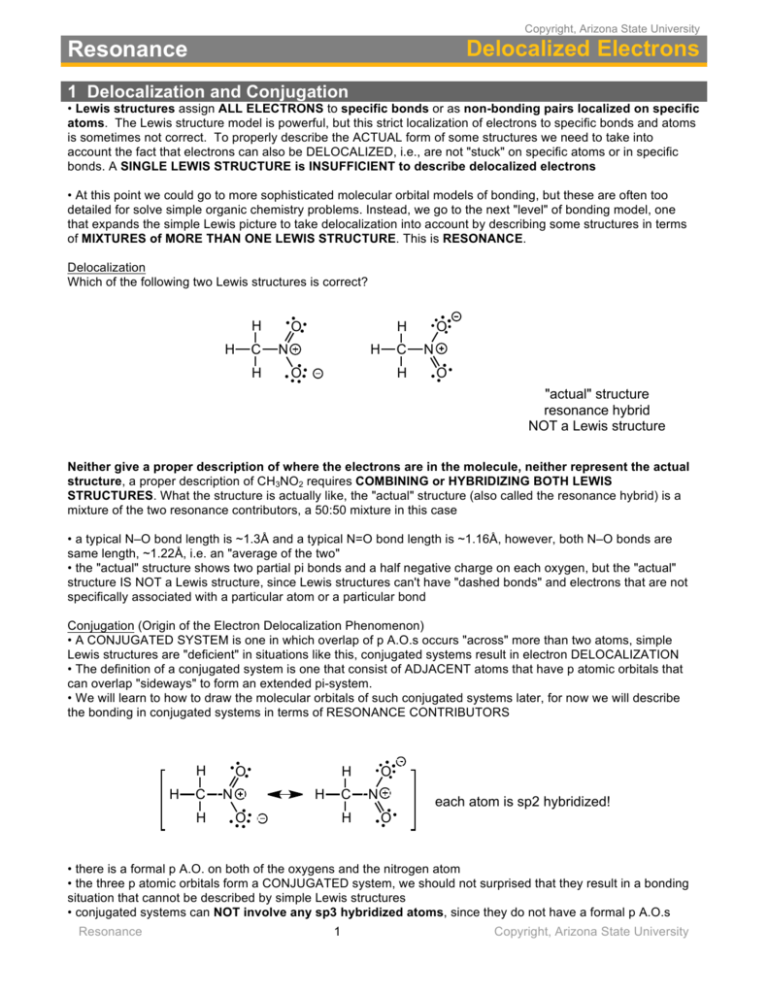
Copyright, Arizona State University Delocalized Electrons Resonance 1 Delocalization and Conjugation • Lewis structures assign ALL ELECTRONS to specific bonds or as non-bonding pairs localized on specific atoms. The Lewis structure model is powerful, but this strict localization of electrons to specific bonds and atoms is sometimes not correct. To properly describe the ACTUAL form of some structures we need to take into account the fact that electrons can also be DELOCALIZED, i.e., are not "stuck" on specific atoms or in specific bonds. A SINGLE LEWIS STRUCTURE is INSUFFICIENT to describe delocalized electrons • At this point we could go to more sophisticated molecular orbital models of bonding, but these are often too detailed for solve simple organic chemistry problems. Instead, we go to the next "level" of bonding model, one that expands the simple Lewis picture to take delocalization into account by describing some structures in terms of MIXTURES of MORE THAN ONE LEWIS STRUCTURE. This is RESONANCE. Delocalization Which of the following two Lewis structures is correct? sp2 resonance arrow O H H H resonance brackets C N H H O sp2 50% C H + 50% sp2 H O = N O sp2 two resonance CONTRIBUTORS H C O 1/2 N O 1/2 H "actual" structure resonance hybrid NOT a Lewis structure Neither give a proper description of where the electrons are in the molecule, neither represent the actual structure, a proper description of CH3NO2 requires COMBINING or HYBRIDIZING BOTH LEWIS STRUCTURES. What the structure is actually like, the "actual" structure (also called the resonance hybrid) is a mixture of the two resonance contributors, a 50:50 mixture in this case • a typical N–O bond length is ~1.3Å and a typical N=O bond length is ~1.16Å, however, both N–O bonds are same length, ~1.22Å, i.e. an "average of the two" • the "actual" structure shows two partial pi bonds and a half negative charge on each oxygen, but the "actual" structure IS NOT a Lewis structure, since Lewis structures can't have "dashed bonds" and electrons that are not specifically associated with a particular atom or a particular bond Conjugation (Origin of the Electron Delocalization Phenomenon) • A CONJUGATED SYSTEM is one in which overlap of p A.O.s occurs "across" more than two atoms, simple Lewis structures are "deficient" in situations like this, conjugated systems result in electron DELOCALIZATION • The definition of a conjugated system is one that consist of ADJACENT atoms that have p atomic orbitals that can overlap "sideways" to form an extended pi-system. • We will learn to how to draw the molecular orbitals of such conjugated systems later, for now we will describe the bonding in conjugated systems in terms of RESONANCE CONTRIBUTORS conjugated system sp2 H H C O N H sp2 O H H C O H N each atom is sp2 hybridized! O sp2 • there is a formal p A.O. on both of the oxygens and the nitrogen atom • the three p atomic orbitals form a CONJUGATED system, we should not surprised that they result in a bonding situation that cannot be described by simple Lewis structures • conjugated systems can NOT involve any sp3 hybridized atoms, since they do not have a formal p A.O.s Resonance 1 Copyright, Arizona State University The Allyl Anion as an Example • Each carbon of the allyl anion (below) is sp2 hybridized, the three carbon atoms represent a conjugated system since the p atomic orbitals can overlap to form an extended pi-system, resulting in delocalized electrons • Which 2 p A.O.s make the formal (Lewis) pi bond and which has the formal negative charge? The molecule isn't sure either!! This is what conjugation and delocalization is all about two resonance contributors EACH CONTRIBUTES 50% these 2 H sp2 Hsp2sp2 make the πH C bond H C H H C C C C H H 50 : these 2 MUST also make a π-bond CONJUGATED H = H 50 H H 1/2 C C C H H H 1/2 H H "actual" structure resonance hybrid 50 : 50 mixture C sp3 H compare –CH3 hybridized (VSEPR) • Resonance contributors are contained within resonance brackets, and combined (mixed) using a resonance arrow, each resonance contributor is a correct, but incomplete, Lewis Structure • Why is the carbon with the formal negative charge sp2 hybridized, when the methyl anion is sp3 hybridized? Because, by being sp2 hybridized it can provide a p A.O. to the conjugated system, and in doing to it gets involved in extended pi-bonding, which means that the electrons on that carbon are DELOCALIZED. Delocalization allows ALL of the electrons to "see" more nuclei, which lowers their energy! • The conjugated system includes all three carbon atoms. If we try to draw the anion according to the rules of Lewis structures then we must draw TWO Lewis "contributors", and understand that neither is a correct representation of the anion on its own, but that the correct, "actual" structure of the anion can be obtained by combining, hybridizing, or mixing the two contributors • The "actual" structure has all of the electrons that can be involved in bonding, in partial (dashed) bonds. Resonance does NOT MEAN rapidly oscillating back and forth between the resonance contributors, the nuclei are NOT IN DIFFRENT POSITIONS in the resonance contributors. • Resonance contributors are also NOT isomers, they represent the REQUIRED different ways of indicating where delocalized electrons are within the "confines" of the Lewis structure "language", they are different ways of drawing the SAME THING, together they CONTRIBUTE to the actual conjugated structure A Mule an as Example • Image that there was no word in English for a mule. A mule is a mixture of a horse and a donkey, and so we could make up a word for a mule by combining the words horse and donkey. • So, a resonance mixture of a HORSE and a DONKEY generates a resonance hybrid mixture of the two, which is the MULE, the MULE is the "actual" animal that we are trying to describe, when we say "Horse-Donkey" MULE = [ HORSE "actual" resonance hybrid DONKEY ] ~50% ~50% resonance contributors • This is exactly the situation we have when trying to draw the bonding and electron distribution in conjugated systems, there is no way of properly describing the bonding in conjugated systems using the Lewis structure "language", which is why we use resonance contributors Benzene as an example 2 • Each carbon in the 6-membered ring is sp hybridized, each has 1 p A.O., we have a CONJUGATED SYSTEM • Taking this into consideration, we find that there are TWO ways that we can draw the pi-bonds in a benzene ring Resonance 2 Copyright, Arizona State University sp2 H C sp2 C H sp2 H sp2 sp2 H C C draw the sp2 π-bonds C C H H H C C C H H C H H C C C H = C C C H H C C H H H EACH CONTRIBUTES 50% H H C H C C H C H C H "actual" hybrid structure all carbons sp2 hybridized H C • These two ways represent the resonance contributors required to describe the actual structure of benzene • delocalization of the electrons in benzene in this way lowers their energy, increases stability, lowers reactivity • the "actual" structure has all electrons that can be involved in bonding in partial (dashed) bonds. • benzene is properly described as a 50:50 MIXTURE of the two contributors above 2 Curved Arrow "Pushing" • although writing resonance contributors seems more complex than simply drawing one "actual" structure, we will see that resonance is essential to understand many chemical processes involving delocalized electrons • it is also important to be able to describe how the different resonance contributors are related using the conventional "curved arrow pushing" language of organic chemistry The Allyl anion again • The resonance contributors we looked at previously are not the same thing just "flipped over", we can show this using deuterium "labeling". Recall, D is just an isotope of H CONJUGATED deuterium "labels" these two H atoms H H D C C D 50% C H D C C D H 50% C H H H C D H = 1/2 C 2 C 1/2 sp 2 sp sp2 D H "actual" resonance hybrid structure all carbons sp2 hybridized 50 : 50 hybrid mixture • the allyl cation consists of a 50:50 mixture of the two resonance contributors shown • BECAUSE it is an exact 50:50 mixture we can assign exactly 1/2 negative charge to the 2 carbon atoms on the actual structure, resonance tell us WHERE the negative charge is, it is NOT on all 3 carbon atoms! • the formal negative charge can either be on the carbon that had the hydrogen atoms, or on the carbon that has the deuterium atoms, the deuterium labeling show that the second contributor is not the first one "flipped over" • the "actual" hybrid structure has all electrons that can be involved in bonding in partial (dashed) bonds, so no non-bonding electrons are included in this "actual" structure. An Example Problem : Draw the resonance contributors for the following radical H C H H H C C C H H C H H C H H H C C C H C H radical H H C H H C H C H C H C H δ means "part" of an electron H H δ δ δ H H C C = C C C H H H "actual" resonance hybrid structure • resonance describes delocalization of single electrons in addition to electron pairs • note the use of "single-headed" fishhook arrows for single electrons • note the use of a Greek delta to indicate a "partial electron" in the actual structure, we use this terminology when there isn't an obvious simple fractional electron population on the atom • ALL carbon atoms involved in resonance must "contribute" a p atomic orbital therefore all must be sp2 or sp hybridized, all of the carbons are part of the CONJUGATED SYSTEM Resonance 3 Copyright, Arizona State University 3 Major, Minor (and Unreasonable) Resonance Contributors Actual structures are often not equal mixtures of the resonance contributors Major and Minor Contributors: The Enolate anion as an Example H H C H O sp2 sp2 H C C O >1/2 O H H H < 50% A C H C H C sp2 = H > 50% B sp2 C H C sp2 C <1/2 H H H "actual" resonance hybrid structure H sp2 • oxygen is more electronegative than carbon, the electrons ARE LOWER IN ENERGY IN THE ELECTRON DISTRIBUTION REPRESENTED by the contributor B compared to A • therefore, the two do not contribute equally to the "actual" structure, B is the major resonance contributor • there is MORE OF B in the MIXTURE, the "actual" structure "looks" more like B • The unequal resonance contributors tell us that in this case there is an unequal distribution of charge between the carbon and the oxygen atoms, i.e. there is greater than half a negative charge on the oxygen and less than half a negative charge on the carbon atom • in the "actual" hybrid structure, all of the delocalized electrons that can be involved in bonding are in partial (dashed) bonds, non-delocalized non-bonding electrons that do not "move" are shown as fixed non-bonding • THE LOWER THE FORMAL ELECTRON ENERGY IN THE CONTRIBUTOR, THE MORE IT CONTRIBUTES TO THE MIXTURE, THE MORE THE ACTUAL STRUCTRURE LOOKS LIKE THAT CONTRIBUTOR! Example Problem: Which is the major resonance contributor? Look at the formal electron distribution in the various contributors, the one(s) with the lowest energy formal electron energy is(are) the major contributor(s) sp3 not part of the conjugated system <1/2 H3C CH C H3C CH N C N = H3C CH "actual" resonance hybrid structure N major minor H3C C N CH C sp sp sp >1/2 3-atom conjugated system • the negative charge is on the more electronegative nitrogen in the (second) major contributor (lower formal electron energy) • the second (major) contributes more to the mixture, therefore, there is greater than 1/2 a negative charge on nitrogen in the actual structure Example Problem: Draw other resonance contributors, indicate the major and minor and draw "actual" structure conjugated system NH2 H3C CH2 C sp3 NH2 H3C CH2 NH2 C NH2 NH2 H3C CH2 equal major (more bonds) minor SP2 δ NH2 C NH2 SP2 NH2 H3C CH2 C δ δ "actual" resonance hybrid structure • the most important factor in determining the major contributor is usually the number of electrons that are in bonds, the more electrons in bonds (since this is usually the most important factor contributing to electron energy), the more important the resonance contributor Resonance 4 Copyright, Arizona State University Unreasonable Resonance Contributors We will often be able to draw resonance contributors that are "legal", but where the electrons are distributed in such a way that they are very high in energy and therefore hardly contribute to the mixture, such contributors can be described as unreasonable, how unreasonable is unreasonable will (unfortunately) depend upon the context, but in most cases unreasonable contributors will be easy to identify since they will have multiple separated charges (which increases energy due to the Coulomb law) Example 1: Only some of the carbon atoms in this cation will be reactive, those that carry a partial positive charge. Exactly how is the charge in this cation distributed, and among which carbon atoms? • The important question about this cation is "where are the electrons and where is the positive charge?", we are not concerned with very high energy minor (unreasonable) resonance contributors since they do not tell us much about our question, which is about the main properties of the cation reactive legal but so high in energy it is very minor and unreasonable in this context δ δ X = reactive • the unreasonable contributor is not "wrong", it represents a legal way to distribute the electrons in this cation, however, it is very minor because compared to the other two, the electron distribution would be very high, it has one less formal bond and also separates charges, which costs energy according to the Coulomb law, its contribution to the resonance hybrid mixture (i.e. the actual cation) would be negligible, including it would not help us to answer the question where the partial charges are • the other two contributors tell us how are the electrons and charges delocalized 4 Resonance and Hybridization • The purpose of resonance is to describe what a structure ACTUALLY looks like, this includes defining the hybridizations of the atoms in the actual structure since this is connected to geometry and bonding etc. • EACH ATOM involved in resonance MUST be sp2 or sp hybridized, each atom must be capable of providing a p A.O., resonance requires each atom to "provide" a p A.O., i.e. resonance occurs in CONJUGATED SYSTEMS • Resonance involves electrons that are non-bonding and/or are in pi-bonds, because these are the electrons that can be part of a CONJUGATED SYSTEM Example resonance/conjugated system sp3 not involved not conjugated H H H H C C H C C H sp2 2 H sp H C C H C C H H H H H conjugated • Taking into account BOTH of the resonance contributors we find that THREE of the carbons are sp2 hybridized, we need to consider BOTH contributors to determine hybridization • The sp3 hybridized carbon is not part of the conjugated system, it is not involved in resonance Example Problem: What is the hybridization of the oxygens and the central carbon in the following structure? all sp2 conjugated conjugated H3C H3C C O O 1/2 O O = C O H3C C O 1/2 • both oxygens MUST be sp2 hybridized AND the central carbon must also be sp2 hybridized Resonance 5 Copyright, Arizona State University • any atom to which you can draw a double bond to in ANY resonance contributor must be sp or sp2 hybridized • hybridization must be the same in all resonance contributors, because the contributors are only different ways of drawing the SAME THING, all atoms involved in resonance must be either sp2 or sp hybridized (or they could not be conjugated) Example Problem: What is the hybridization of the circled nitrogen? sp3 sp2 X H3C N sp H3C N sp N δ N = sp N N sp H3C N N H3C N conjugated N δ N N 2 although possible to draw, this is "unreasonable" • it must be sp2 hybridized since we can draw another resonance contributor with a double bond to that nitrogen • the hybridization of all atoms must be the same in all resonance contributors, because the contributors are only different ways of drawing the SAME THING • EACH atom involved in resonance is conjugated, all are sp2 or sp hybridized in the case of the OTHER two nitrogen atoms, each must be capable of contributing a p A.O. (which is impossible; if they are sp3 hybridized) 5 Minor Resonance Contributors: When one Lewis IS the Actual structure • Sometimes we use resonance in an VERY DIFFERENT CONTEXT • Many species ARE described well by a single Lewis structure, we do not need additional resonance contributors to determine the actual structure, we already have it • However, there are sometimes SMALL displacements in the electron distributions that are not "captured" well by Lewis structures, dipole moments are an example of this Example: How do we use Lewis structures to tell us about small charge redistributions that occur as a consequence of different electronegativities among the atoms in the molecule below, and thus give us information about the C=O bond dipole moment?? • The bond dipole moment is a MINOR charge redistributions in an otherwise stable neutral molecule, therefore we will necessarily be concerned with MINOR resonance contributors that are would otherwise be unreasonable. • Although very minor, they are still useful in predicting reactivity. H H C H O C H C H H H H C O C C H H H H (very) minor H C O C C H H H H "actual" structure! H • In this context, the minor contributor tells us how the electrons are unevenly distributed in the molecule, it gives us the same information as drawing a dipole moment symbol on the bond. O δ H + Cδ C C H H H H H • THERE IS NO "ACTUAL" STRUCTURE IN THIS CASE, the first structure is already a good "actual" structure, • The minor contributor does inform us about the small partial negative charge on the oxygen, and small partial positive charge on the carbon, the minor contributor is so minor it doesn't make sense to draw a partial pi-bond • the "delta" symbol often used to indicate "some" charge, especially when the actual charge is very small (as in this case), or it is not obvious how much charge there is Example: Phenol Resonance 6 Copyright, Arizona State University How does the presence of the -OH group attached to the benzene ring result in minor charges in the charge distribution in the benzene ring? In this case we are interested in what would in other contexts be considered minor (unreasonable) resonance contributors, we are interested in minor changes in electron distribution. OH OH OH OH OH OH δ =δ phenol minor resonance contributors δ δ • We need to consider very minor, otherwise "unreasonable" resonance contributors in this context in order to figure out which specific carbons in the benzene ring carry small partial negative charges • Note that we have now getting more sophisticated and subtle information than in the dipole moment case above, the only way we can get the information we need is via minor resonance contributors • we will find that consideration of minor resonance contributors such as these help us to understand reactivity of many organic molecules • AGAIN, there is no "actual" structure, the actual structure was the first structure, instead we can use the minor resonance contributors to find out where to put the small partial charges, the delta partial charge symbols Summary of When "Unreasonable" or "Very Minor" Resonance Contributors are IMPORTANT…….. • Whether a minor resonance contributor is "unreasonable" or is informative depends upon the context • When we are trying to find an actual structure, i.e. where the electrons really ARE in a structure (usually in an anion, cation or radical), then very minor contributors are not helpful and are "unreasonable" since we are not interested in minor electron displacement, we really just need to know where the electrons ARE • When we are asking about small or minor electron redistributions in what are usually stable organic molecules, when we already KNOW what the ACTUAL structure is, then we can take minor contributors into consideration, and in this context, they would not be considered unreasonable since we are trying to find out about minor electron displacements 6 "Guidelines" for Resonance Some "guidelines" when considering resonance contributors • When considering major and minor contributors • Consider the total electron energy for each contributor individually, the lower the electron energy associated with that particular electron distribution, the more important (likely to be major) that contributor is • Non-bonding electrons are usually higher in energy than bonding electrons, electrons in bonds are usually the most important factor to consider for electron energy • Electrons associated with LESS electronegative atoms are HIGHER in energy than those on more electronegative atoms • Electrons on atoms with formal negative charges are usually higher in energy • Separation of charges costs energy according to the Coulomb law • Usefulness and "unreasonableness" for resonance contributors depends upon the context, see above • When moving electrons • for delocalized structures with non-bonding electrons that are involved in resonance, "get" the high energy electrons into a bond first, these are usually the non-bonding electrons • because of the requirement for conjugation, you can only put electrons into a bond to an adjacent atom • for delocalized structures with no non-bonding electrons, usually cations, the best place to start is usually to move electrons towards the site of the positive charge • ONLY atoms that are part of the conjugated system, i.e. that can provide a p A.O. and thus must be sp2 or sp hybridized, can be involved in generating resonance contributors • look for the "smallest" movement of the electrons (arrows) to avoid missing an important contributor Resonance 7 Copyright, Arizona State University Example Problem Which carbons on the following cation carry partial positive charges? Draw all reasonable resonance contributors. X δ = unreasonable in THIS CONTEXT H δ δ H sp3, not involved in resonance • the unreasonable structure is unreasonable because it is not telling us where the charges really are Example Problem: Draw all reasonable resonance contributors for the following cation • start by moving pi-bonding electrons towards the positively charged carbon • note that drawing 2 arrows at once, as above, is not wrong, it just "misses" the central resonance contributor, drawing the arrows as shown below does not miss any of the contributors Example Problem. Draw all reasonable resonance contributors for the following anion to determine which atoms will have partial negative charge, and assign the major and minor contributors N START with the highest energy electrons H N H N H δ N H δ O O minor major O "actual" resonance hybrid O δ • start by moving the highest energy non-bonding electrons into a bond with an adjacent atom, and move the pielectrons in the C=O pi-bond to avoid having 5 bonds to the carbon atom of the C=O bond • it would have been equally correct to move the pi-electrons towards the carbon of the C=N pi-bond also • in this case it is necessary to draw 2 arrows at once this time to generate the third contributor from the second • NOTE, the electrons that do not move, that are localized, are shown as non-bonding in the actual structure, those that are delocalized, that move, that are involved in resonance are not shown since they are "in" the partial pi-bonds • NOTE, in this case it is not possible to decide exactly how much each contributes to the mixture (it is NOT 1/3 + 1/3 + 1/3) and so the delta symbol with the charges is appropriate in the actual structure here Resonance 8 Copyright, Arizona State University 7 Resonance and Stability Consider the following two cations A and B……… H H 1/2 C C H H H 1/2 C H H H "actual" charge "diluted" C C H H C C H H H C H C H H H H C H C H A resonance stabilized, less reactive C H more reactive H B FULL charge • Structure A has delocalized electrons, delocalization allows the electrons to "see" more nuclei, which lowers their energy (actually more their kinetic energy rather than electrostatic energy) • This is a THERMODYNAMIC argument for reduced reactivity hat says the cation is less energetic therefore is it less reactive • In Structure A, the positive charge is also delocalized onto two carbons, each has only 1/2 a positive charge • This "dilutes" the positive charge, making each carbon with the positive charge less reactive, this is a KINERIC argument for reduced reactivity • DON'T get too worried about the difference between the kinetic and thermodynamic arguments at this point, we will return to this later in the semester, just be able to recognize that resonance usually means stability, lower electron energy, less chemical reactivity X Consider the following two anions, A or B, which is more reactive? • remember, higher energy electrons are more reactive • delocalization lowers the energies of electrons since it allows them to "see" more nuclei • resonance means delocalization H HA B 2 resonance can NOT move electrons to sp3 hybridized atom contributors, less stable 3 resonance contributors more stable LESS reactive anion • the non-bonding electrons in BOTH are delocalized, in neither are the electrons localized on the carbon atoms indicated in the structures provided • the non-bonded electrons in A are delocalized onto 2 carbon atoms, 2 resonance contributors can be drawn • the non-bonded electrons in B are MORE delocalized, 3 resonance contributors can be drawn • the electrons on B are more stable, anion B is less chemically reactive • For example, anion B would be a weaker Bronsted base, and its conjugate acid would be a stronger Bronsted acid, this is one way that we will use resonance later in the semester Consider the following two radicals A and B……… H H H C H C C H H H C C H H C H H A resonance stabilized, less reactive H H C H C H C H more reactive H B Q. Which is more reactive? A. B is not resonance stabilized, is more reactive We will use these concepts that relate resonance and stability extensively in this course! Resonance 9 Copyright, Arizona State University



